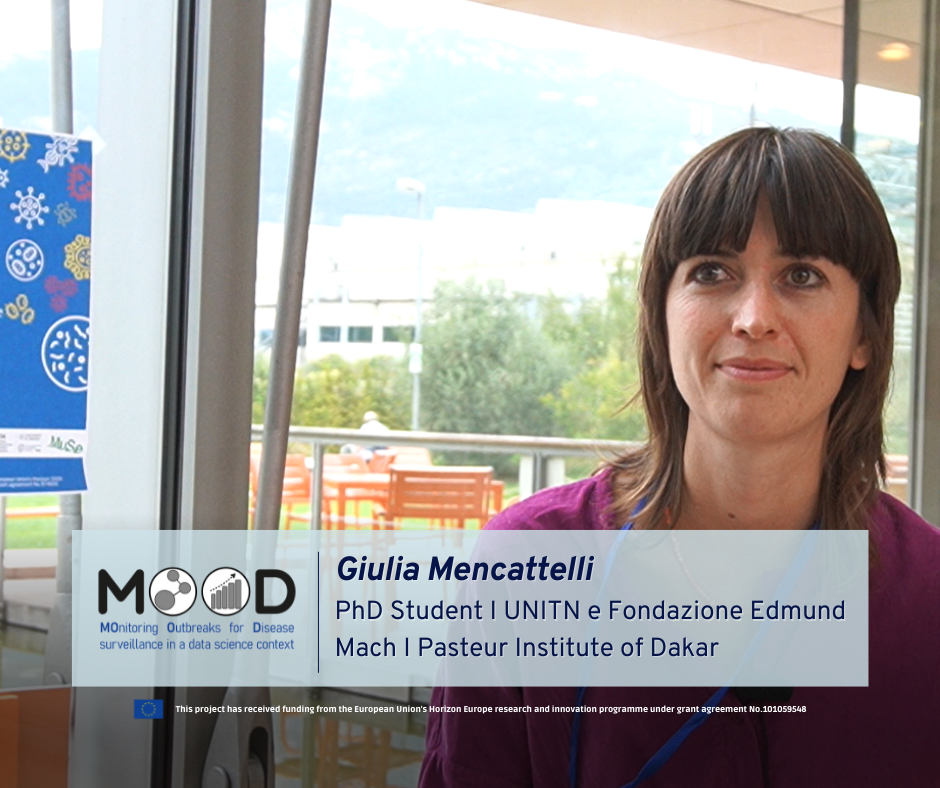Giulia Mencattelli currently conducts a PhD between the University of Trento, Italy, Fondazione Edmund Mach, also based in Trento, Istituto Zooprofilattico of Teramo and the Pasteur Institute in Dakar, Sénégal. During the MOOD international workshop in Trento, she gave a sharp presentation about “West Nile virus Lineage 2 overwintering in Italy”. Following this presentation, she was asked a few questions regarding her topic, but also about international collaboration, by MOOD’s Working Package 8 OpenGeoHub’s communication experts. Here’s how it went.
Could you tell us your name and your current field of study? “
“I am Giulia Mencattelli, I am a PhD student. I am conducting a PhD between Italy and Senegal. In particular, I am working with the University of Trento, the Fondazione Edmund Mach, and the Pasteur Institute of Dakar. The PhD is about West Nile Virus circulating between Italy and Senegal and trying to understand if there is a possible circulation between these two countries and potential integration from Africa to Europe or from Europe to Africa.”
Your research work highlighted a raising concern for public health: the overwintering capacity of West Nile-vector mosquitoes. What consequences does this discovery have on WN surveillance strategies?
“Yes, with my presentation I show how many mechanisms there are at the basis of overwintering of West Nile Virus. There is not only one. They are multiple mechanisms that combined together allow the persistence of the virus in different countries. The surveillance system depends on where you look at it. For example in Italy, the surveillance system is very strong and has been implemented since 2001, since the introduction of the West Nile Virus in Italy. It keeps monitoring actively and passively West Nile Virus and the country is divided into high, medium, and low-risk areas. And based on this they choose to early detect the West Nile virus in Italy. So from the Public point of view, this surveillance is well done. Even if of course there are always ways to improve early detection, by for example implementing active surveillance in the winter time, to early detect the virus spread at this time of year. Wild bird rescue centers could also provide data to better surveil the virus.”
You have plenty of experience abroad, with part of your PhD conducted in Senegal. How important is an international collaboration with over-ocean countries in disease surveillance?
“I think it’s great to have this kind of collaboration and for me to have been able to collaborate with the Pasteur Institute in Senegal because International collaboration is a great way to exchange expertise. For example, in Africa, they have a lot of epidemics of different viruses that we don’t have. But with climate change, they may be introduced in Western countries. So collaboration is always very important because it first opens minds, we can share things and expertises. For example in Senegal, there is a good team, that created a set of primers for genome sequencing for West Nile Virus and Usutu Virus, and now with my team, we are validating these primers, along with Istituto Zooprofilattico of Teramo. Because they have a lot of expertise with primer validation and a lot of bird samples. So combing these two institutions made possible the creation of this project and the study of the circulation of a virus between two countries so it is important to keep on collaborating.”
Thank you again to Giulia Mencattelli for granting us this interview. To go further about signs and drivers of zoonotic diseases’ emergence and digital data resources for Epidemic Intelligence, you can watch video interviews of international experts on the MOOD dedicated page.


